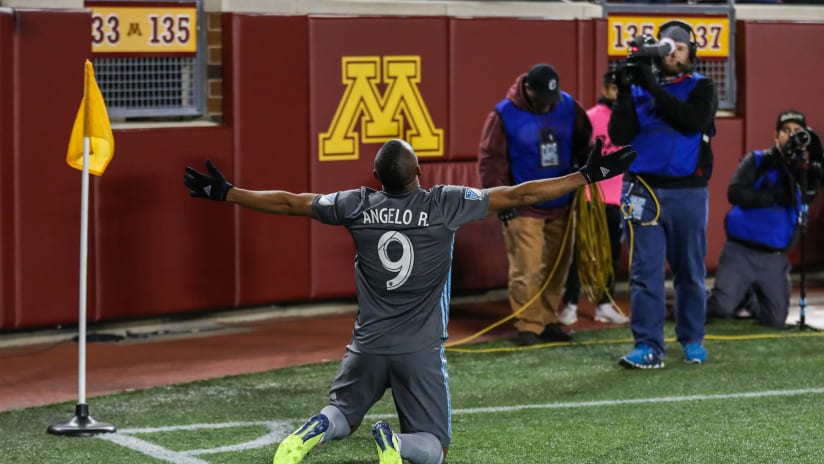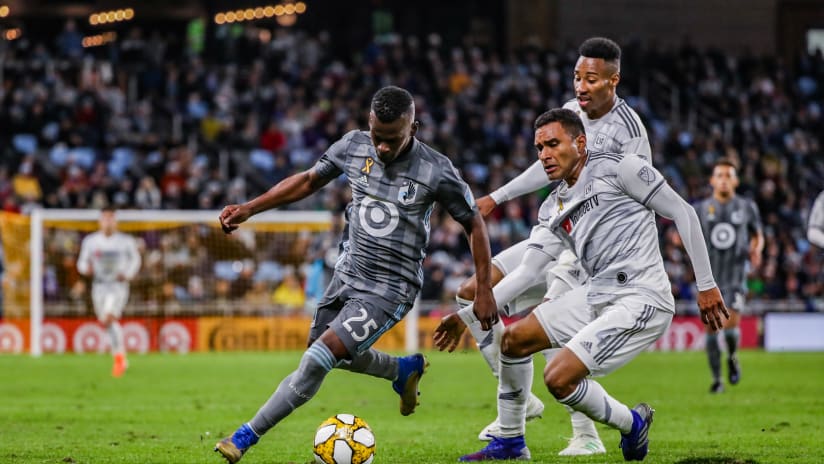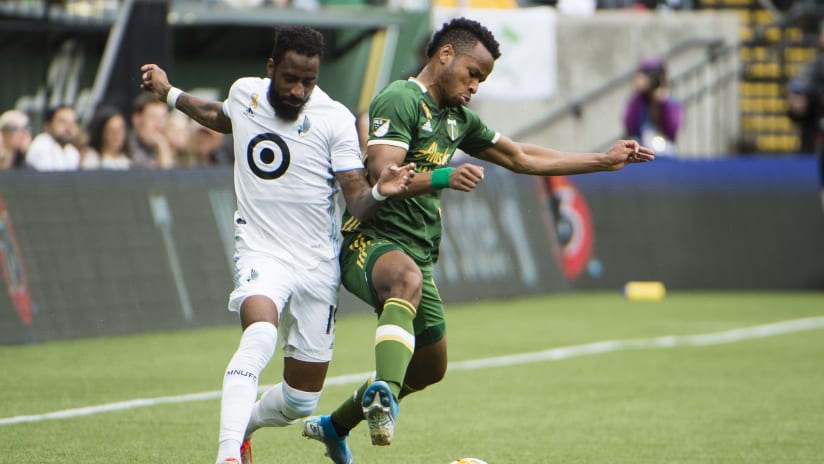Forward Angelo Rodriguez’s brace in last week’s 2-1 win over NYCFC not only saw him at last uncorking some of the goal-scoring that fans have been waiting for since he joined the team, but also showcased his instincts and patience as a player. At first blush, his second goal might look like a bit of luck as he jumped on a poor pass by defender Ben Sweat back to goalkeeper Sean Johnson and practically walked the ball in in the 35th minute.
But if you back the tape up and follow Rodriguez from the beginning of the game, you’ll see that the goal was actually the result of a concerted strategy based on what Rodriguez saw as the game was unfolding.
In the clip below from the 14th minute, you can see the Loons are pressuring the ball through the midfield as part of an overall approach. As soon as the ball comes in to NYCFC’s Victor Castellanos, Collen Warner is marking him tightly and Miguel Ibarra falls back from the right wing to double him up and cut off a passing lane. Once Castellanos sees his options cut off, he sends the ball back to reset the play. Sweat receives it and then sends it back to Alexander Callens, who cycles it back to Johnson in goal. As he does this, you can see Rodriguez make a run directly at Johnson.
Nothing comes of it in that moment, but it forces Johnson to send the ball long immediately, rather than taking time to get comfortable and allow his team to get into a better position.
“It is a little bit like the reverse of a defender,” said Head Coach Adrian Heath, talking about Rodriguez’s consistent hounding of the backline. “You always have to think the worst — that your partner is going to fall or he is going to miss the header. As a front man, you are always thinking, ‘Is he going to underhit that back pass, is he going to make a mistake?’ It is an innate sort of feeling that strikers have. You are always thinking that people are going to make mistakes.”
The clip below is from the 17th minute, and it again shows Minnesota United’s ability to deploy a press that keeps NYCFC from advancing through the middle third on the ground. Once again, as soon as Castellanos gets the ball, he’s pressured first by Ibarra and then by Rasmus Schuller, forcing him to track back and eventually give the ball to Callens. Callens is under almost immediate pressure from Rodriguez and he’s forced into playing it back to Johnson, who is under pressure from an onrushing Darwin Quintero.
NYCFC, who are a heavily possession-based team (they had 67.8% of the possession on the night), are more comfortable playing the ball back than trying to break the press directly. Minnesota United are relying on them to behave that way, in fact, and are hoping for a breakdown somewhere along the way.
That moment came in the 35th minute, once again courtesy of pressure from Minnesota United — mostly from Ibarra, again — and from a cheeky bit of legerdemain from Rodriguez. As Ibarra runs onto a hopeful ball forward from defender Jerome Thiesson, Sweat corrals it and takes a moment to assess his options. He looks back at Ibarra for a split second and then up at centerback Sebastien Ibeagha, who is gesturing for Sweat to play it back to Johnson, just as they had been doing all through the first half.
What Sweat doesn’t see is Rodriguez lurking behind Ibeagha. The instant that Sweat drops his eyes to the ball to knock it back to Johnson, Rodriguez is off.
“If you look at it, he actually hides himself behind the central defender at one stage so Ben Sweat does not see him in the beginning,” said Heath. “It is not a good ball from the defender, but he anticipated it. More importantly, then his first touch was really good because he did not get it caught under his feet. He had the big touch to make sure he went around the keeper.”
Rodriguez’s work in the first half is emblematic of what he can bring to the team going forward. It happens that he was the beneficiary of that work on his second goal, but while scoring is good and should be expected of a striker, it’s the work he puts in probing and pushing at the backline to open up opportunities for himself or Quintero or Ibarra (or Kevin Molino or Ethan Finlay next year) or another player that is maybe the most valuable part of his game.





